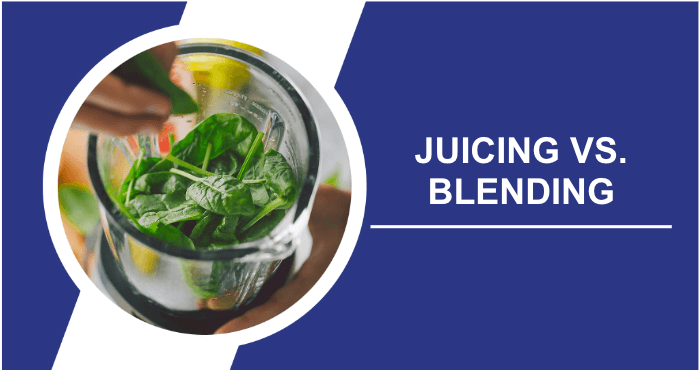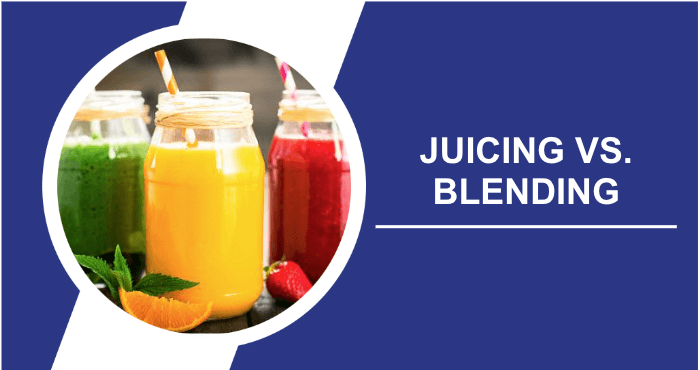The health beverage industry is growing not just in the United States but globally. More and more individuals are becoming conscious of their choices and focusing on what they consume. This trend is exemplified by the market value of the fresh juice and smoothie sector, which reached an estimated $2.36 billion in 2020.
It is crucial to have an understanding of your nutritional options while planning your meals with health in mind. One important aspect to consider is whether “juicing vs. Blending” is more effective for achieving weight loss goals. Additionally when access to produce is limited, fruit and vegetable supplements can be a viable alternative.
To achieve a weight it’s essential to make changes in your eating habits rather than sticking to the same set of foods and beverages. Among the components that should be included in your meals, fruits and vegetables hold great importance. This article delves into two approaches for creating nutritious beverages along, with their respective benefits. Equipped with this knowledge you’ll be able to make decisions that align with your goals.
Juicing vs. Blending: A Weight Loss Comparison When it comes to making drinks understanding the differences between juicing and blending can lead you to the conclusion that blending is a better choice for weight loss. Whole fruits and vegetables offer benefits to our bodies. They have calorie content and are rich in essential vitamins and minerals.
Freshness plays a role when incorporating these nutritious elements into our diet. While many people opt for salads another great option is to extract juice or make smoothies by either juicing or blending these fruits and vegetables. These beverage choices allow us to enjoy our drinks while treating ourselves with delights.
Smoothies And Juices – What Makes Them So Healthy?
Smoothies and juices are, like a form of vitality providing a delightful and nutritious way to nourish our bodies. Filled with an array of fruits, vegetables and sometimes even superfoods they offer a burst of flavor and promote good health in every sip. What sets them apart is their ability to provide a concentrated amount of essential vitamins, minerals and antioxidants that our bodies readily absorb.
Whether you’re enjoying a green smoothie or a tangy citrus juice these vibrant mixtures not only please the palate but also enhance energy levels, aid digestion and support overall well being. They serve as a reminder that taking care of our health can be enjoyable and delicious.
Can I Lose Weight With Smoothies Or Juices?
Embarking on a journey to lose weight using smoothies or juices may seem enticing. These colorful concoctions can definitely be part of a rounded approach to managing weight. However it’s important to keep in mind that they aren’t potions that guarantee instant results. Achieving weight loss requires a combination of factors, such as maintaining a healthy diet engaging in regular exercise and making overall lifestyle choices.
While smoothies and juices can contribute by providing nutrients and assisting with portion control they should be seen as supplements rather than substitutes for a comprehensive approach. The key, to achieving success lies in practicing moderation staying consistent and committing to long term well being.
What Sets Juicing Apart From Blending?

Juicing
Juicing refers to the extraction of juice from fruits and vegetables. This process involves using a juicer to remove components such as seeds, pulp and fibrous materials. The outcome is an mineral rich juice with reduced fiber content. There are two types of juicers commonly utilized:
Centrifugal
Centrifugal juicing is a speedy method employed to extract juice from fruits and vegetables. The juicer rapidly grinds these ingredients into pulp while separating the liquid. Both centrifugal and cold press methods can be utilized for making fresh juice with no substantial difference in their nutritional content.
Cold Press
In contrast cold press juicing entails a process that crushes fruits and vegetables. This deliberate pace allows for a yield of juice from these ingredients.
Blending
Unlike juicing blending allows you to keep the fiber intact while creating a beverage. When you opt for blending you’re able to enjoy an nourishing drink. To embark on your blending journey it’s important to have a blender at hand.
Here’s how it works; Begin by gathering your ingredients, including fresh fruits and vegetables. Chop these elements into pieces and place them in the blender along, with water or any healthy liquid of your preference. Then simply blend away—there’s no need to worry about removing seeds or pulp.
Blending magically transforms these ingredients into an luscious liquid. The beauty of smoothies lies in their versatility. While many people start with a foundation of fruits and vegetables you can elevate the health benefits of your smoothie by incorporating other ingredients, such as
- Liquids (water, plain yogurt, milk)
- Sweeteners (stevia, honey, pitted dates)
- Nuts (groundnuts, cashew nuts, walnuts)
- Seeds (chia seeds, flax seeds, sunflower seeds)
- Spices (ginger, turmeric, cinnamon)
- Herbs (dill, basil, thyme)
- Herbal supplements (matcha powder, minerals, protein powder)
By adding these ingredients to your smoothie you can enjoy a drink that not only aids in weight loss but also provides various health benefits. You have the option to make three kinds of smoothies right in the comfort of your own home;
Green Smoothies
As the name suggests green smoothies get their vibrant color from ingredients like fresh spinach, parsley or cucumber. The best way to prepare them is by including leafy greens as the component of your blend. In green smoothies vegetables play a significant role and outweigh other ingredients. It’s worth noting that these veggies retain their fiber content resulting in a fibrous beverage.
Fruit Smoothies
Fruit smoothies tend to focus on fruits and less on vegetables. While you can add ingredients it’s important to maintain a high ratio of fruit compared to other elements.
Protein Smoothies
Protein smoothies strike a balance by combining fruits, vegetables and a good source of protein. The healthiest options for protein sources, in these blends include protein powder, plain yogurt or cottage cheese. Consistently incorporating protein into your diet contributes to overall health.
Understanding the Nutritional Aspects
Before deciding between juicing and blending it’s important to familiarize yourself with both methods. Once you have a grasp of each technique you can make an informed comparison. One helpful approach is to explore the value specifically the vitamins and minerals present in each type of drink. This assessment will assist you in determining which option is more beneficial for your weight loss goals.
Essential Fiber
Dietary fiber plays a role in supporting various bodily functions especially aiding digestion. When juicing, all fiber in the form of pulp is removed. On the hand blending smoothies retains the fiber content as theres no extraction involved. Fiber is essential for bodily processes and can even offer relief from issues, like constipation. It exists in two forms:
Insoluble Fiber
Insoluble fiber, which is vital for maintaining digestion can be found abundantly in green vegetables and cauliflower. These fiber components contribute to the volume of your stool. Facilitate regular bowel movements. When it comes to the fiber content opting for fruits and vegetables is preferable as smoothies retain a substantial amount of fiber due to the inclusion of pulp.
Soluble Fiber
On the hand soluble fiber can be found in citrus fruits, pears, apples, green beans and carrots. This type of fiber dissolves in water. Plays a role in slowing down the digestive process while helping to regulate blood sugar levels.
Sugar Content
Another important factor to consider when comparing juicing with blending is the sugar content, in these beverages. Both methods face a challenge as they can result in high sugar levels in the final product. Consequently frequent consumption of these beverages may lead to blood sugar levels.
However when comparing the two options juicing tends to have a sugar content. This is mainly because fruit juices are lighter in consistency making it easier to drink servings at once. The juice you consume the more it can raise your blood sugar levels. On the hand smoothies have a thicker and more satisfying texture.
After enjoying one or two servings of smoothies you may notice that you don’t feel a need for more food or drinks. This is because smoothies contain fruits and vegetables which can help reduce your daily calorie intake – an important aspect when trying to lose weight. In contrast juices may not provide the level of fullness potentially leading you to consume larger quantities.
It’s important to mention that another factor contributing to the sugar content of juices is the addition of additives. While these beverages are typically made from juices some people choose to include sweeteners or extra sugar. However this practice can be problematic as sugar consumption can have negative effects, on your overall health and well being.
Juices or Smoothies: Which is Better for Antioxidants?
Antioxidants play a role in safeguarding our bodies by protecting cell walls from the harmful effects of free radicals, which are culprits behind various diseases. The good news is that you can easily obtain antioxidants from the fruits and vegetables you include in your daily diet. When deciding between juicing and blending it’s important to consider the antioxidant levels in the resulting beverage.
Research indicates that blending is a choice when it comes to maximizing your daily intake of antioxidants. In essence sweet fruits and vegetables have a concentration of antioxidants in their membranes rather than their water content. So when you remove the pulp you unintentionally discard a portion of these valuable antioxidants that are essential, for boosting your immune system.
Blending vs. Juicing – Which Is Easier To Digest?
When it comes to the ease of digestion both juicing and blending have their advantages. Lets explore how each method impacts the process: Juicing removes most of the fiber rich pulp leaving you with a refreshing drink that gives your digestive system a bit of a break. On the hand smoothies retain a significant amount of fiber and other pulpy materials for your body to digest.
This continuous stimulation of your system generally promotes good health and contributes to healthy digestion. However it’s crucial to consider your health requirements when deciding between juicing and blending. If you need to consume fiber in your diet then blending is the recommended choice.
It can be beneficial for conditions such as cancer, heart disease and high blood pressure where fiber plays a role. Conversely if you have a condition that necessitates lower fiber intake for easier digestion then juicing may be a suitable option. In any case seeking advice from a healthcare professional is advisable, for guidance based on your unique health situation.
Where Can I Find Good Smoothies And Juices Recipes?
Uncovering smoothie and juice recipes feels like discovering a treasure trove of both taste and nutrition. You can explore a plethora of ideas in cookbooks, health blogs and on social media platforms such as Pinterest and Instagram. Don’t forget to check out the community at your local gym or wellness center; they often share their tried and true recipes.
Moreover smartphone apps and recipe websites provide an abundance of options allowing you to personalize your creations according to your preferences and dietary needs. So whether you’re, in search of a summer blend or a satisfying winter smoothie the realm of recipes is just a click or turning page away ready to enhance your culinary journeys.
Juicing Vs. Blending – What Equipment Do I Need?
Uncovering smoothie and juice recipes feels like stumbling upon a treasure trove of deliciousness and nutritional goodness. You can discover a plethora of inspiration in cookbooks, health blogs or on popular social media platforms like Pinterest and Instagram. Don’t forget to tap into the community at your local gym or wellness center; they often generously share their tried and true recipes.
Additionally smartphone apps and recipe websites provide an abundance of options allowing you to personalize your creations according to your taste and dietary preferences. So whether you’re craving a blend for summer or a robust smoothie, for winter an array of recipes is just a click away or waiting to be discovered within the pages of a cookbook ready to enhance your culinary exploration.
Conclusion
To sum it up juicing and blending are two methods used to create beverages, each with its own advantages and considerations. Juicing allows you to make fresh drinks packed with vitamins and minerals depending on the fruits and vegetables you use. However it does remove fiber components. On the hand blending is a more nourishing option as it retains the pulp, seeds and fiber for a well rounded drink.
It’s worth noting that blended smoothies may not suit everyones taste due to their texture. Blending also provides versatility in terms of ingredients that can be added such as nuts, seeds, supplements and different liquids. This opens up possibilities for even healthier drink choices.
When it comes to weight loss goals blending tends to be a choice since juicing removes much of the pulp. This can lead to overconsumption and elevated blood sugar levels. Blended smoothies are thicker and more satisfying in nature which can help promote moderation, in consumption—an aspect of maintaining healthy habits.
Ultimately deciding between juicing and blending should be based on your health objectives, dietary preferences and specific nutritional requirements. It would be wise to seek advice from a healthcare expert who can provide recommendations on selecting the most suitable option, for your overall health and well being.
Frequently Asked Questions
What sets juicing apart from blending?
Juicing involves extracting the liquid from fruits and vegetables leaving behind the pulp and fiber. On the hand blending incorporates all parts of the ingredients resulting in a thicker and more fibrous beverage.
Are there any health advantages to juicing?
Indeed juicing can provide a source of essential vitamins and minerals. However it lacks the fiber content in whole fruits and vegetables.
Which option is superior for weight loss; juicing or blending?
Blending is generally considered favorable for weight loss as it retains fiber, which promotes satiety and helps regulate calorie intake. Juicing if not consumed in moderation can lead to sugar intake.
Which option offers antioxidant benefits?
In terms of antioxidant intake blending is typically more beneficial as it preserves an amount of the antioxidant rich membranes found in fruits and vegetables.
Can juicing or blending assist with specific health conditions?
Certainly! Both methods can be advantageous depending on ones condition. Blending is often recommended for those who require fiber intake while juicing may be suitable for individuals with conditions that necessitate a lower fiber intake. It’s always important to consult with a healthcare professional, for advice.
Resources
- Statista. (2022). “Juice and Smoothie Bar Sector Market Size US 2022.” Statista. [Online] Available at: Link.
- Pem, D. and Jeewon, R. (2015). “Fruit and Vegetable Intake: Benefits and Progress of Nutrition Education Interventions – Narrative Review Article.” Iranian Journal of Public Health, 44(10), pp. 1309–1321. [Online] Available at: Link.
- Gholamreza Khaksar, Kitipong Assatarakul, and Supaart Sirikantaramas (2019). “Effect of Cold-Pressed and Normal Centrifugal Juicing on Quality Attributes of Fresh Juices: Do Cold-Pressed Juices Harbor a Superior Nutritional Quality and Antioxidant Capacity?” Heliyon, 5(6), pp. e01917–e01917. [Online] DOI: Link.
- McCartney, D., Rattray, M., Desbrow, B., and Christopher Garry Irwin (2018). “Smoothies: Exploring the Attitudes, Beliefs, and Behaviors of Consumers and Non-Consumers.” ResearchGate. [Online] Available at: Link.
- Rogers, P. and Shahrokni, R.O. (2018). “A Comparison of the Satiety Effects of a Fruit Smoothie, Its Fresh Fruit Equivalent, and Other Drinks.” Nutrients, 10(4), p. 431. [Online] DOI: Link.
- Henning, S.M., Yang, J., Shao, P., Lee, R.-P., Huang, J., Ly, A., Mark Ming-Long Hsu, Lu, Q., Thames, G., Heber, D., and Li, Z. (2017). “Health Benefit of Vegetable/Fruit Juice-Based Diet: Role of Microbiome.” Scientific Reports, 7(1). [Online] DOI: Link.
- Anderson, J.M., Baird, P., Davis, R.A., Ferreri, S.P., Knudtson, M., Ashraf Koraym, Waters, V., and Williams, C.M. (2009). “Health Benefits of Dietary Fiber.” Nutrition Reviews, 67(4), pp. 188–205. [Online] DOI: Link.
- Kaczmarczyk, M., Miller, M.I., and Freund, G.G. (2012). “The Health Benefits of Dietary Fiber: Beyond the Usual Suspects of Type 2 Diabetes Mellitus, Cardiovascular Disease, and Colon Cancer.” Metabolism, 61(8), pp. 1058–1066. [Online] DOI: Link.
- Murphy, M., Barrett, E.C., Bresnahan, K.A., and Barraj, L.M. (2017). “100% Fruit Juice and Measures of Glucose Control and Insulin Sensitivity: A Systematic Review and Meta-Analysis of Randomized Controlled Trials.” Journal of Nutritional Science, 6. [Online] DOI: Link.
- Paglia, L. (2019). “The Sweet Danger of Added Sugars.” European Journal of Pediatric Dentistry, 20(2), pp. 89–89. [Online] DOI: Link.
- Barber, T.M., Kopf, S., Pfeiffer, A., and Weickert, M.O. (2020). “The Health Benefits of Dietary Fiber.” Nutrients, 12(10), p. 3209. [Online] DOI: Link.
- Medlineplus.gov. (2020). “Low-Fiber Diet: MedlinePlus Medical Encyclopedia.” [Online] Available at: Link.
- Rahman, K. (2007). “Studies on Free Radicals, Antioxidants, and Co-factors.” Clinical Interventions in Aging, 2(2), pp. 219–236. [Online] Available at: Link.
- Uckoo, R.M., Jayaprakasha, G.K., Balasubramaniam, V.M., and Patil, B.S. (2012). “Grapefruit (Citrus paradisi Macfad) Phytochemicals Composition Is Modulated by Household Processing Techniques.” Journal of Food Science, 77(9), pp. C921–C926. [Online] DOI: Link.
Jayson Peterson is an experienced pharmacist, naturopathic physician, medical examiner, and minister. After earning his Doctor of Pharmacy degree from the Medical University of South Carolina, Jayson Peterson completed clinical rotations at several prestigious healthcare institutions and has been affiliated with several pharmacy chains throughout his career. His main passion and zeal is focused on providing world-class patient care by giving precise details and thorough instructions to those who need it most.

